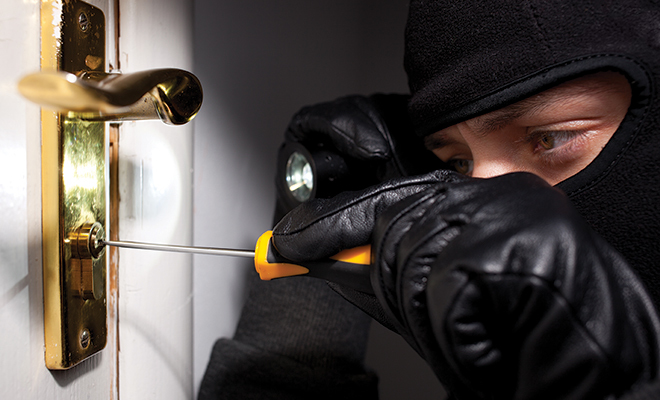
Protecting Your Home From Burglars
The FBI estimates that in the U.S. there are 5,400 residential burglaries every day, with an average loss of $1,600, a total of $15.7 billion a year. Is your home at risk? While you may not be able to make your home 100 percent break-in proof, there are things you can do to keep it from being an easy target for crooks. Here are six ways you can make your home more secure.
Get a four-legged alarm.
You don’t need a guard dog. Burglars aren’t afraid of the bite; they’re afraid of the bark. Even the world’s most friendly dog can be the best deterrent against break-ins. Size doesn’t matter–large dogs can be intimidating and small dogs bark sooner and longer than bigger dogs. Even it you can’t have a dog, put a “beware of the dog” sign on your front door and leave a dog food bowl or a leash where they can be seen. Or buy an electronic dog, a motion sensor that triggers a recorded sound of an irate barking canine. Burglars won’t take a chance finding out if the bark is real.
Discourage window shopping
Burglars case homes looking for valuable items and the easiest way inside without being seen. Do your tall shrubs provide cover for break-ins? Are valuables easy to see through ground floor windows? Trim bushes so they grow no higher than windowsills, and burglars can’t hide there. Close curtains and blinds when you’re gone so that strangers can’t spot easy-to-steal and -fence valuables. In many cities, local law enforcement will inspect your home and recommend things you (and your neighbors) can do to make your home safer. Talk with a local police community service officer about becoming one of the 30 million people who belong to Neighborhood Crime Watch programs. Then get to know your neighbors and watch out for each other.
Don’t advertise
Burglars look for houses where no one is home. More break-ins happen during regular work hours than during the dead of night. But you can discourage unwelcome intruders by making it seem that there’s someone home even when nobody is there. Purchase an inexpensive light timer ($5 to $40), then set it to switch lights (and maybe a radio or television) on about 30 to 45 minutes before it gets dark. If you are leaving for an extended vacation, cancel your mail delivery and newspaper and ask a neighbor to remove any advertising flyers left at your door. Have someone keep the grass mowed and walks shoveled. Park your car in the garage so it doesn’t sit on the street in the same place for days. Thieves know that when lights are on for 24 hours a day the house is probably empty, so set your light timer to switch off at bedtime. And don’t post “On my way to Paris” or “Family night at the bowling alley” on social media! Burglars use social media, too.
Light up the night
Burglars like to work under the cover of darkness. Outside lighting is an economical way to keep burglars off your property. Keep yards and entranceways brightly lighted, using a motion-sensitive lighting system. The best lighting is shielded and neighbor-friendly and does not create areas of deep shadows where burglars can hide. Install exterior lights out of reach so housebreakers can’t unscrew the light bulbs.
Get Alarmed
An electronic home security system is a good way to discourage intruders. Even simple systems will help. Better yet are professionally installed and monitored networks. Look for surveillance systems with real-time internet surveillance and recording. Some systems include web-connected cameras that will record any burglar who might enter your home. Your home insurance agent can recommend a system that’s right for you. Many burglars know how to disable alarms if they know the type they’re dealing with, so put a sign in your yard indicating your home has an alarm system without showing the brand name.
Lock it up
Install quality locks on all doors, windows, garages and sheds and then use them. Don’t rely on knob locks; install deadbolt locks on all exterior doors. For fire safety, make sure yours can be opened from the inside; if you have keyed deadbolts adjacent to a glass door panel, make sure the key is available when you are home. Burglars know that simply popping sliding doors off their frames can be an easy way inside. Get a dowel or steel bar and use it to block the door from opening. Secure windows by slipping a nail into window frames so they can’t be easily opened from the outside. Keep doors locked when you’re home as well; home invasions can occur when you’re outdoors or in a separate wing of the house.
By securing your home and possessions, you’re also safeguarding the health of your family and your own peace of mind. HLM
Sources: bankrate.com, howstuffworks.com and jcsd.org.







